2016 Audi Q3 vs. 2016 BMW X1, 2017 Infiniti QX30, 2016 Lexus NX200t, 2016 Mercedes-Benz GLA250
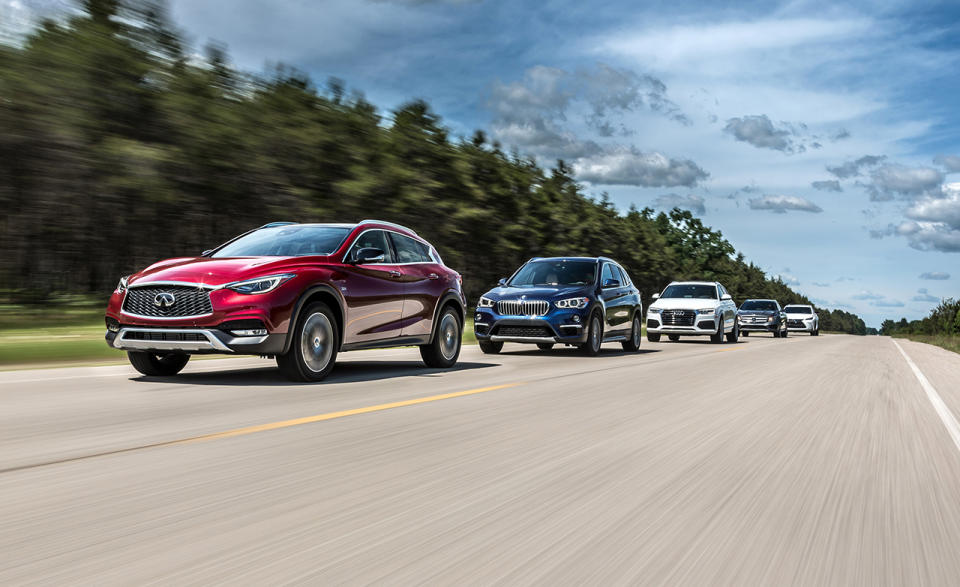
From the September 2016 issue
Just as LeBron James, the Cleveland Cavalier forward, is far more likable than LeBron James, the Miami Heat forward, a hatchback called a crossover trumps a two-box vehicle by any other name. It’s a matter of selling perception as much as a tangible product, and Americans have fully bought in.
With the crossover elbowing out the sedan as the vehicle of choice for the everyman, the smallest, most affordably priced premium utes now serve as the entrée to luxury-brand ownership. Simultaneously, the perpetual upward trajectory of vehicle sizes and prices has left a gaping hole for a class of tiny crossovers below the Audi Q5, the BMW X3, and the Lexus RX. These smallest crossovers start around $36,000, with all-wheel drive optional if not standard and a 2.0-liter turbocharged inline-four the consensus powertrain.
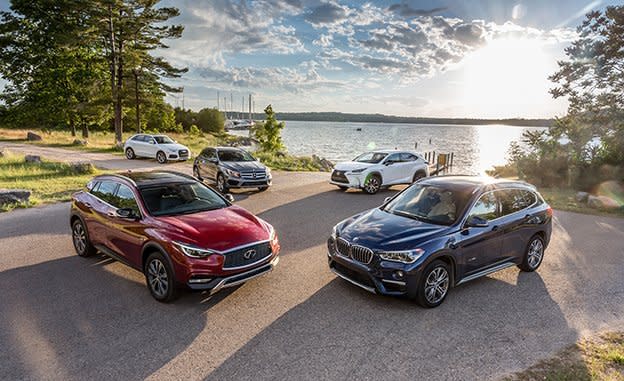
BMW launched this burgeoning segment in the U.S. in 2013 with the X1, then completely rethought its approach three short years later. While the current X1 is only all-wheel drive (for the time being, at least), its dubious distinction as the first BMW in the States built on a front-wheel-drive architecture riles loyalists who cringe at the inevitability of front-drive BMWs. For this class, though, where driving dynamics take a back seat to comfort, convenience features, and, well, the back seat itself, it’s hard to argue with BMW’s decision. Our test car was loaded with $10,125 worth of options, including a self-parking feature, a Harman/Kardon stereo, and a massive panoramic glass roof for a total of $45,920.
You might expect Audi, no stranger to selling small premium cars in the U.S., to have an advantage in this particular game. The tall and stubby crossover kin to the A3, the Q3 is not yet based on the VW Group’s newest MQB platform, though. Instead, it uses the older PQ35 architecture that dates to the fifth-generation VW Golf. Our Prestige-trim tester packed a power liftgate, power-folding mirrors, LED headlights, a Bose sound system, and a sport package with upgraded seats, handy shift paddles, and selectable drive modes for $43,090.
The Lexus NX200t checks in almost 10 inches longer than the Audi and 500 pounds heavier than Mercedes’ entrant, although the envelope doesn’t feel significantly larger from the inside. While the NX is only Lexus’s second unibody crossover, the brand is working from deep experience. The larger RX has been synonymous with luxury crossovers for 20 years. Our NX test car came with the F Sport cosmetics-and-seating package that only serves to make the front fascia more garish. An optional summer-tire package (not fitted to our test car) is the only F Sport mechanical change. Adaptive cruise control, real leather seats, a wireless phone charger, and a postage-stamp sunroof made the NX200t the most expensive vehicle in the test at $46,550.
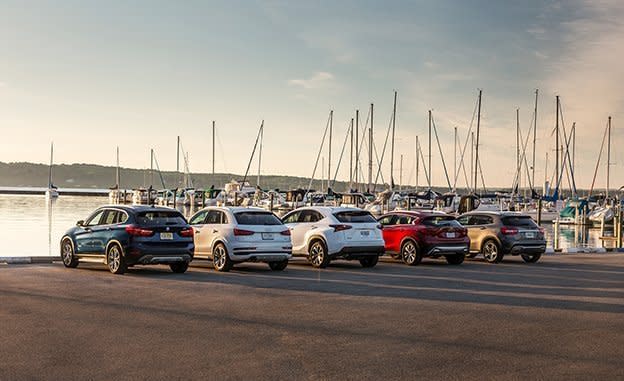
The Mercedes-Benz GLA250 claims the lowest as-tested price at $41,975, with optional equipment including blind-spot monitoring, 19-inch wheels, a rearview camera, panoramic sunroof, and cross-drilled front brake discs. It is the closest thing to a literal hatchback-on-stilts in this test. To create the GLA, Mercedes designers simply massaged the roofline and character creases of Europe’s A-class hatch and lifted the suspension. In another nod to American tastes, the seven-speed dual-clutch transmission is controlled by a column-mounted stalk, which leaves enough prime center-console real estate for a 7-Eleven–approved cupholder—right ahead of two more cupholders.
Infiniti’s QX30 is the freshest design, all-new for 2017, although maybe not quite as new as it appears. Take a look at where the A-pillar meets the hood and front fender, then check out the same stamping on the Mercedes-Benz. The QX30 is a product of a budding partnership between Daimler AG and Renault-Nissan. Built using the same platform and powertrain as the Mercedes, but assembled at Infiniti’s Sunderland, England, plant with different sheetmetal, the QX30 follows the cost-conscious route into a price-sensitive category. And yet, at first glance our Premium-trim QX30 with an estimated as-tested price of $44,000 certainly seems more luxurious than the GLA in this test based on material quality alone. Options included LED headlights, the bird’s-eye Around View Monitor camera system, front and rear parking sensors, and the complete roster of active safety aids.
We attempted to include a sixth competitor, but Lincoln could only provide an MKC with the optional 2.3-liter engine and a price tag in the mid $50,000s. We passed on the MKC to keep the playing field as level as possible, then took to our 10Best route and Michigan’s Old Mission Peninsula to find the most roller-coaster-like roads in the Mitten.
For a segment so green, the Audi Q3 feels surprisingly tired. That’s because, although the Q3 only went on sale in the U.S. in 2015, the design predates the launch by three years. It originally made its debut in Europe for 2012. The dated interior is polka-dotted with a daunting array of buttons, and the driving experience is defined by underwhelming attributes that, frankly, we can’t remember experiencing recently in a luxury vehicle.
Bad manners are headlined by a bouncy and busy ride, perhaps in part because the Q3 rides on the test’s shortest wheelbase, although the suspension tuning doesn’t help. The Q3 pitches and rolls on lumpy roads. It wanders wherever the pavement guides it and is easily pushed around by the wind. The brake pedal is soft enough to be disconcerting even in slow-moving city traffic, and the highway-cruising experience is the loudest in this group.

With the weakest acceleration, a mushy brake pedal, and a humdrum interior, the Q3 not only looks like a potato dumpling, it’s about as spicy as one.
You pilot the Q3 from a strange, city-bus driving position, with a high seat, a low cowl, and a steering wheel that projects upward from the dash as much as it does outward. Several drivers complained about not being able to move the wheel low enough to be comfortable. At least it’s a decent suburban-family bus with a back seat that is reasonably comfortable.
The powertrain combo, with six forward gears and 200 horsepower, hits the right notes in refinement and shift quality. The all-wheel-drive system never allows any of the momentary torque steer or front wheelspin that we occasionally witnessed in the Benz, the Infiniti, or the Lexus. However, the Audi powerplant’s performance ranks at the back of the pack with its 7.8-second amble to 60 mph and 24-mpg thirst in our 600-mile drive.
The Q3 is an anomaly in Audi’s current lineup. It’s not particularly comfortable or gratifying to drive; the proportions are awkward, and the interior appears old and cluttered compared with the sleek, modern, technical cockpits we’ve come to expect from the folks in Ingolstadt.
“That is an incredible piece of costumery,” remarked senior editor and staff word inventor Jared Gall after unfolding himself from the QX30’s cabin. It’s an observation that cuts both ways; few QX30 buyers will ever realize they’re driving the GLA’s fraternal twin.
Thanks to Infiniti’s heavily buffed design language—sheetmetal bulging and taut character lines showing the tension of seams about to burst—the QX30 looks like nothing else. Inside, Infiniti invested in a new dashboard and adapted its own infotainment system, which should be enough to throw the uninformed off the scent. But the climate controls, window switches, and key fob are all lifted from the GLA. The steering wheel is different than the GLA250’s, but only because it’s an older Mercedes part.
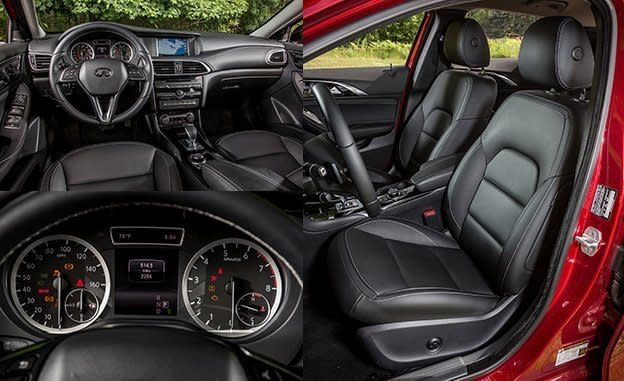
The QX30 is actually an attractive little thing. Unfortunately, the Infiniti has the test’s worst ride quality and is tied with the Audi for least fun to drive.
The distinctions between the QX30 and the Mercedes it’s based on are barely more than skin deep. Infiniti claims full responsibility for tuning the throttle, transmission, steering, and suspension. Yet back-to-back drives in the QX and the GLA suggest the Japanese were stymied when they attempted to better the Germans, who designed the vehicle from the ground up. The QX30’s rear end trundles over rough pavement and the body lists in corners, meaning it both handles and rides worse than the vehicle that gave it life.
The transmission, which offers eco and sport modes, desperately needs a normal mode that shifts later but doesn’t hold a lower-than-necessary gear indefinitely. Presumably, there is no such setting only because the shifter was already labeled with E, S, and M (for manual) to accommodate the AMG GLA45 for which it was originally designed. We averaged 25 mpg, 1 mpg less than the Mercedes, possibly because we frequently switched from the default eco mode to sport.
By outsourcing so much of the QX30’s engineering to Mercedes-Benz, Infiniti directly tied the success or failure of its small crossover to the fate of the GLA250. We’ve mentioned the QX’s shortcomings relative to the GLA, but, in the bigger picture, the Infiniti is intolerably cramped inside, the same chief weakness that plagues our third-place finisher.
With their four-door coupes and SUV coupes, the Germans have become masters of the niche. But despite an ability to foresee (or imagine) small markets for new ideas, they occasionally miss the obvious mass-market appeal of the conventional. The GLA is one such example. Mercedes’ bizarre fusion of a compressed wagonlike body with a crossover’s stance results in a roof that is almost five inches shorter than the Lexus’s. Gall, at 6-foot-7, compared the Mercedes’ claustrophobic interior to a sleeping bag. For normal-size humans, it’s more like a two-person tent. Either way, we’re comparing a $42,000 vehicle to the indignities of camping.
Beyond lacking the basic amenities of headroom, adequate cargo capacity, and a usable rear seat, this particular GLA also lacked simple luxuries such as heated seats, a power passenger seat, and a proximity key. In many ways, it comes off as a marginally nicer Mazda 3, with materials nowhere near as upscale as what we expect from a Mercedes.
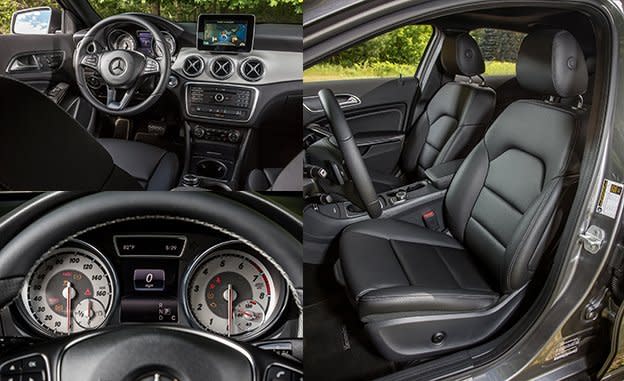
As with its platform-mate, the Infiniti QX30, the low, carlike Mercedes GLA is not convincing in its role as an SUV. Decent lifted hatchback, though.
The GLA rides stiffly but not as clumsily as the Infiniti. Here, the ride penalty feels more like a conscious trade-off made for better-controlled body motions. (The Merc also rides on larger wheels with shorter tire sidewalls.) Light and accurate steering begets precise handling. The seven-speed dual-clutch gearbox engages smoothly from a stop and swaps ratios fluidly on both up- and downshifts. Its throttle response around town can be sluggish if your right foot is too light, but a launch-control program helps the GLA claim the quickest zero-to-60 run at 6.1 seconds. The Infiniti revs to the same 3200 rpm following similar launch-control procedures, but its engine bogs on the launch and its gearbox stumbles during the first upshift. For the QX30, it was quicker to just flat-foot the accelerator, hence the 60-mph time that’s half a second slower.
Relative to the QX30, and even within the larger class, the GLA250 drives nicely, but it’s hardly the complete package. A luxury utility vehicle needs to offer true luxury and utility. The GLA250 delivers neither.
The only vehicle in this test with “sport” in its name is irrefutably the least athletic one. The Lexus NX200t lands a full tenth of a g behind the BMW X1 in cornering grip. Stops from 70 mph require a protracted 183 feet, an astounding 20 feet more than the best-in-test QX30. And despite making the most power at 235 horses, the NX is the second slowest of this group. Dynamically, this F Sport has nothing in common with the Lexus IS350 F Sport that dethroned the long-reigning sports-sedan champ, the BMW 3-series.
The F Sport moniker never should have been applied to the NX200t in the first place, because this Lexus rises near the top of the class by virtue of the comfort and luxury it delivers, qualities that are absent in the third- through fifth-place contenders. From the stitched dashboard to the way the windows slow their roll in the final inch before sealing shut, the upscale touches are visible and tangible. The divine sport seats (which may be justification enough to opt for the F Sport) are generously bolstered and cushioned and the only seats in this test with adequate thigh support for taller drivers. The BMW’s rear seat may be slightly bigger, but the NX’s bench is better sculpted and padded, with plenty of room for two adults.
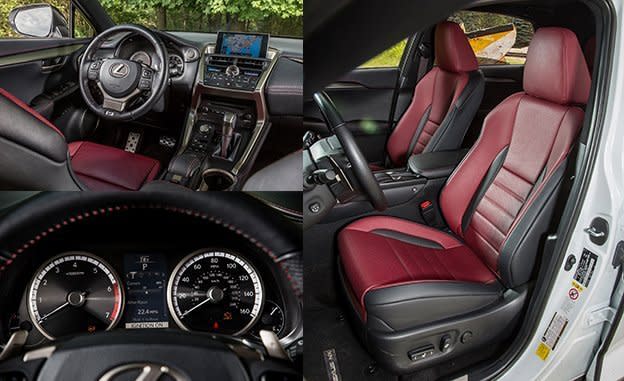
The NX200t F Sport’s hyper-aggressive, anime war-wagon styling is completely at odds with its compliant, comfortable comportment.
The NX’s cockpit remains serene no matter how treacherous the road. The pillowy ride suggests the wheelbase measures longer than its 104.7 inches. While the rest of our convoy bobbed, bounced, and pogoed over expansion joints on what appeared to be a freshly paved stretch of I-75, the Lexus only conveyed its annoyance audibly, with the steady thwap-thwap-thwap of its tires. The boosted four-cylinder feels more linear than most, and the six-speed transmission is seamless enough for its changes to be invisible to the inattentive driver.
And an inattentive driver you will be, because Lexus has trumped all automakers in pilot distraction. The touch-sensitive track pad that controls the screen is one-quarter the size of other interfaces and mimics the sensation of trying to use a laptop in traffic. It’s the one thing in this crossover that can raise your blood pressure.
The X1 cracks the small-luxe-crossover class with a package that’s practical, comfortable, efficient, and upscale, with the added bonus of being fun to drive. There’s a good reason why BMW ran away with the win and a 27-point margin in this test. It is the only automaker that has advanced to a second-generation vehicle in this segment. The latest X1 incorporates the lessons that Mercedes and Infiniti are just now starting to learn.
The original X1, available with rear-wheel drive and an inline-six, was low and wagonlike, with a cramped rear seat. The move to a front-drive architecture for the second iteration caused a lot of hand-wringing, but it makes a lot of sense for the people who buy and live with these vehicles. This new X1’s back seat is a sprawling one, and it’s the only one to slide fore and aft (a $300 option) in this quintet. The BMW also swallowed the most packages in our new practical stowage test using airplane-carry-on-sized boxes. You sit low in the BMW, as you do in the Infiniti and Mercedes, but the roof stretches high above your head to make this the roomiest of the bunch. Large panes of upright glass create a bright cabin with clear sightlines.
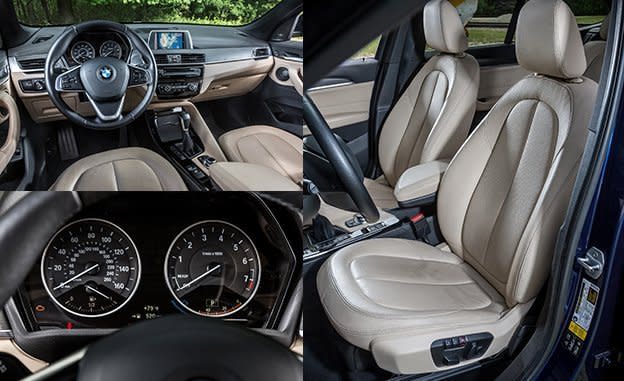
Roomy, practical, handsome enough, efficient, comfortable, quick, and fun to drive: The X1 is easily the best-balanced small, luxury SUVish thing.
It’s true that this new X1 has lost some of the handling prowess that stoked glossy memories of the E91-chassis 3-series wagon, the car that underpinned the original X1. That said, few companies do front-wheel-drive dynamics as well as Mini, which uses this platform in the Clubman. The most neutral handler here waltzed through the slalom and skidpad handling tests on the track and surprised us on back roads with lively turn-in behavior that never felt nervous on the highway. The Aisin transmission, an eight-speed unit for transverse-engine applications, shifts with the same readiness of that other eight-speed ’box that BMW uses to great effect, ZF’s longitudinal transmission for rear-drivers. In conjunction with the 228-hp 2.0-liter four, it contributed to a 6.3-second hustle to 60 mph and the best observed fuel economy at 27 mpg.
For BMW, the X1’s first-place finish isn’t just a victory, but also vindication of its decision to introduce this transverse-engine architecture. The X1 provides sensible packaging, upscale amenities, long-haul comfort, and a driving experience that outstrips anything else in this burgeoning class.
2016 Audi Q3 Quattro2016 BMW X1 xDrive28i2017 Infiniti QX30 AWD2016 Lexus NX200t F Sport AWD2016 Mercedes-Benz GLA250 4MATICVehiclePrice As Tested$43,090$45,920$44,000*$46,550$41,975Base Price$36,725$35,795$36,000*$39,415$35,425DimensionsLength172.8 inches175.4 inches174.2 inches182.3 inches173.9 inchesWidth72.1 inches71.7 inches71.5 inches73.6 inches71.0 inchesHeight62.6 inches62.5 inches60.2 inches64.8 inches60.0 inchesWheelbase102.5 inches105.1 inches106.3 inches104.7 inches106.3 inchesFront Track61.1 inches61.5 inches61.7 inches61.8 inches61.4 inchesRear Track61.2 inches61.6 inches62.0 inches61.8 inches61.4 inchesInterior VolumeF: 48 cubic feet
R: 36 cubic feetF: 53 cubic feet
R: 45 cubic feetF: 50 cubic feet
R: 39 cubic feetF: 53 cubic feet
R: 44 cubic feetF: 49 cubic feet
R: 38 cubic feetCargo BehindF: 48 cubic feet
R: 17 cubic feetF: 59 cubic feet
R: 27 cubic feetF: 34 cubic feet
R: 19 cubic feetF: 55 cubic feet
R: 18 cubic feetF: 42 cubic feet
R: 12 cubic feetPowertrainEngineturbocharged DOHC 16-valve inline-4
121 cu in (1984 cc)turbocharged DOHC 16-valve inline-4
122 cu in (1998 cc)turbocharged DOHC 16-valve inline-4
122 cu in (1991 cc)turbocharged DOHC 16-valve inline-4
122 cu in (1998 cc)turbocharged DOHC 16-valve inline-4
122 cu in (1991 cc)Power HP @ RPM200 @ 6000228 @ 5000208 @ 5500235 @ 5600208 @ 5500Torque LB-FT @ RPM207 @ 1700258 @ 1250258 @ 1250258 @ 1650258 @ 1250Redline / Fuel Cutoff6600/680 rpm7000/6500 rpm6400/6300 rpm6250/6250 rpm6300/6300 rpmLB Per HP18.616.317.017.116.9DrivelineTransmission6-speed automatic8-speed automatic7-speed dual-clutch automatic6-speed automatic7-speed dual-clutch automaticDriven WheelsallallallallallGear Ratio:1/
MPH Per 1000 RPM/
Max MPH1 3.95/5.7/39
2 2.30/9.8/67
3 1.56/14.5/99
4 1.16/19.5/127
5 0.86/26.3/12
6 0.69/32.8/1271 5.25/4.8/31
2 3.03/8.0/51
3 1.95/12.2/79
4 1.46/16.5/107
5 1.22/19.7/128
6 1.00/24.0/129
7 0.81/29.7/129
8 0.67/35.9/1201 3.86/4.6/27
2 2.43/7.5/45
3 1.54/11.1/70
4 1.05/16.5/104
5 0.78/22.5/131
6 0.61/28.7/131
7 0.48/37.0/1201 3.30/5.8/36
2 1.90/9.6/60
3 1.42/13.4/84
4 1.00/18.9/118
5 0.71/26.3/126
6 0.61/31.0/1261 3.86/4.6/27
2 2.43/7.5/45
3 1.54/11.1/70
4 1.05/16.5/104
5 0.78/22.5/130
6 0.61/28.7/130
7 0.48/37.0/120Axle Ratio:13.453.204.604.154.60ChassisSuspensionF: struts, coil springs, anti-roll bar
R: multilink, coil springs, anti-roll barF: struts, coil springs, anti-roll bar
R: multilink, coil springs, anti-roll barF: struts, coil springs, anti-roll bar
R: multilink, coil springs, anti-roll barF: struts, coil springs, anti-roll bar
R: multilink, coil springs, anti-roll barF: struts, coil springs, anti-roll bar
R: XXXXBrakesF: 12.3-inch vented disc
R: 11.1-inch discF: 13.0-inch vented disc
R: 11.8-inch vented discF: 12.6-inch vented disc
R: 11.6-inch discF: 12.9-inch vented disc
R: 11.1-inch discF: 12.6-inch vented, cross-drilled disc
R: 11.6-inch discStability Controlpartially defeatablefully defeatable, traction offpartially defeatablepartially defeatable, traction offpartially defeatable, launch controlTiresContinental ContiProContact
255/40R-19 100H M+SPirelli Cinturato P7 All Season Run Flat
225/50R-18 95V M+SContinental ProContact TX SSR
235/50R-18 97H M+SYokohama Geolandar G91 HV
225/60R-18 100H M+SGoodyear Eagle LS2 RunOnFlat
235/45R-19 95H M+SC/D Test ResultsAcceleration0–30 MPH2.8 sec2.4 sec2.3 sec2.3 sec2.2 sec0–60 MPH7.8 sec6.3 sec6.6 sec7.1 sec6.1 sec0–100 MPH21.8 sec17.1 sec18.1 sec20.5 sec17.3 sec0–120 MPH38.8 sec27.8 sec31.4 sec37.7 sec29.5 sec¼-Mile @ MPH16.1 sec @ 8914.9 sec @ 9415.1 sec @ 9215.5 sec @ 8914.8 sec @ 93Rolling Start, 5–60 MPH8.2 sec7.3 sec7.2 sec7.7 sec7.4 secTop Gear, 30–50 MPH4.0 sec3.5 sec3.4 sec3.9 sec3.4 secTop Gear, 50–70 MPH5.5 sec4.6 sec4.7 sec4.8 sec4.5 secTop Speed127 mph (gov ltd)129 mph (gov ltd)131 mph (gov ltd)126 mph (gov ltd)130 mph (gov ltd)ChassisBraking 70–0 MPH174 feet170 feet163 feet183 feet173 feetRoadholding,
300-ft-dia Skidpad0.85 g†0.86 g0.83 g0.76 g0.84 g610-ft Slalom40.9 mph†41.1 mph40.2 mph†39.0 mph†40.5 mph†WeightCurb3719 pounds3721 pounds3534 pounds4014 pounds3517 pounds%Front/%Rear57.2/42.856.5/43.560.2/39.859.1/40.959.7/40.3CG Height25.0 in23.5 in25.0 in25.0 in25.0 inFuelTank16.9 gallons16.1 gallons14.8 gallons15.9 gallons14.8 gallonsRating91 octane91 octane91 octane91 octane91 octaneEPA Combined
/City/Hwy23/20/28 mpg26/22/32 mpg27/24/32 mpg*24/22/27 mpg27/24/32 mpgC/D 600-Mile Trip24 mpg27 mpg25 mpg24 mpg26 mpgPractical StowageNO. OF 9 X 14 X 22-IN BOXES, seats up/folded5/167/195/167/165/16Length of Pipe119.5 in125.0 in117.5121.0 g117.0 gLargest flat panel, length x width62.0 x 38.5 in65.5 x 39.5 in63.5 x 41.0 in68.8 x 44.0 in63.5 x 41.3 inSound LevelIdle42 dBA40 dBA41 dBA37 dBA42 dBAFull Throttle74 dBA75 dBA76 dBA74 dBA73 dBA70-MPH Cruise71 dBA70 dBA69 dBA69 dBA70 dBA
*C/D est. †Stability-control inhibited.tested by Eric Tingwall and David Beard in Chelsea, Michigan
Final ResultsMax Pts. Available2016 BMW X1 xDrive28i2016 Lexus NX200t F Sport AWD2016 Mercedes-Benz GLA250 4MATIC2017 Infiniti QX30 AWD2016 Audi Q3 QuattroRank12345VehicleDriver Comfort1089776Ergonomics1096877Rear-seat Comfort554213Rear-seat Space*555332Cargo Space*554313Features/Amenities*10108787Fit and Finish1089888Interior Styling1097777Exterior Styling1066777Rebates/Extras*510100As-tested Price*201818201919Subtotal1008476736869Powertrain1/4-mile Acceleration*202017201914Flexibility*534244Fuel Economy*10107987Engine NVH1098768Transmission1098768Subtotal555144454341ChassisPerformance*201915181919Steering Feel1088766Brake Feel1097775Handling1097767Ride1099767Subtotal605446464444ExperienceFun to Drive252117171414Grand Total240210183181169168

* These objective scores are calculated from the vehicle's dimensions, capacities, rebates and extras, and/or test results.

 Yahoo Autos
Yahoo Autos 